FORD C MAX 2013 Owners Manual
Manufacturer: FORD, Model Year: 2013, Model line: C MAX, Model: FORD C MAX 2013Pages: 552, PDF Size: 8.55 MB
Page 251 of 552

BREAKING-IN
You need to break in new tires for approximately 300 miles
(480 kilometers). During this time, your vehicle may exhibit some unusual
driving characteristics. The engine also needs to break in. Avoid hard
accelerations and driving too fast for the first 1000 miles. If possible,
avoid carrying heavy loads up steep grades during the break-in period.
ECONOMICAL DRIVING
Fuel economy is affected by several things such as how you drive, the
conditions you drive under and how you maintain your vehicle.
There are some things to keep in mind that may improve your fuel
economy:
•Accelerate and slow down in a smooth, moderate fashion.
•Drive at steady speeds.
•Anticipate stops; slowing down may eliminate the need to stop.
•Combine errands and minimize stop-and-go driving. (When running
errands, go to the furthest destination first and then work your way
back home.)
•Close the windows for high-speed driving.
•Drive at reasonable speeds. (Traveling at 65 miles per
hour/105 kilometers per hour uses about 15 percent less fuel than
traveling at 75 miles per hour/121 kilometers per hour).
•Keep the tires properly inflated and use only the recommended size.
•Use the recommended engine oil.
•Perform all regularly scheduled maintenance.
There are also some things you may want to avoid doing because they
reduce your fuel economy:
•Avoid sudden or hard accelerations.
•Avoid revving the engine before turning off the car.
•Avoid long idle periods.
•Do not warm up your vehicle on cold mornings.
•Reduce the use of air conditioning and heat.
•Avoid using speed control in hilly terrain.
250Driving Hints
2013 C-Max Full Hybrid(34h)
Owners Guide gf, 3rd Printing, January 2013
USA(fus)
Page 252 of 552
![FORD C MAX 2013 Owners Manual •Do not rest your foot on the brake pedal while driving.
•Avoid carrying unnecessary weight (approximately 1 mile per gallon
[0.4 kilometers per liter] is lost for every 400 pounds [180 kilograms] FORD C MAX 2013 Owners Manual •Do not rest your foot on the brake pedal while driving.
•Avoid carrying unnecessary weight (approximately 1 mile per gallon
[0.4 kilometers per liter] is lost for every 400 pounds [180 kilograms]](/img/11/58725/w960_58725-251.png)
•Do not rest your foot on the brake pedal while driving.
•Avoid carrying unnecessary weight (approximately 1 mile per gallon
[0.4 kilometers per liter] is lost for every 400 pounds [180 kilograms]
of weight carried).
•Avoid adding particular accessories to your vehicle (e.g. bug
deflectors, rollbars/light bars, running boards, ski racks).
•Avoid driving with the wheels out of alignment.
DRIVING THROUGH WATER
If driving through deep or standing
water is unavoidable, proceed very
slowly. Never drive through water
that is higher than the bottom of
the wheel rims (for cars) or the
bottom of the hubs (for trucks).
When driving through water, traction or brake capability may be limited.
Also, water may enter your engine’s air intake and severely damage your
engine or your vehicle may stall.
Note:Driving through deep water where the transmission vent tube is
submerged may allow water into the transmission and cause internal
transmission damage.
Note:Once through the water, always dry the brakes by moving your
vehicle slowly while applying light pressure on the brake pedal. Wet
brakes do not stop the vehicle as quickly as dry brakes.
Driving Hints251
2013 C-Max Full Hybrid(34h)
Owners Guide gf, 3rd Printing, January 2013
USA(fus)
Page 253 of 552
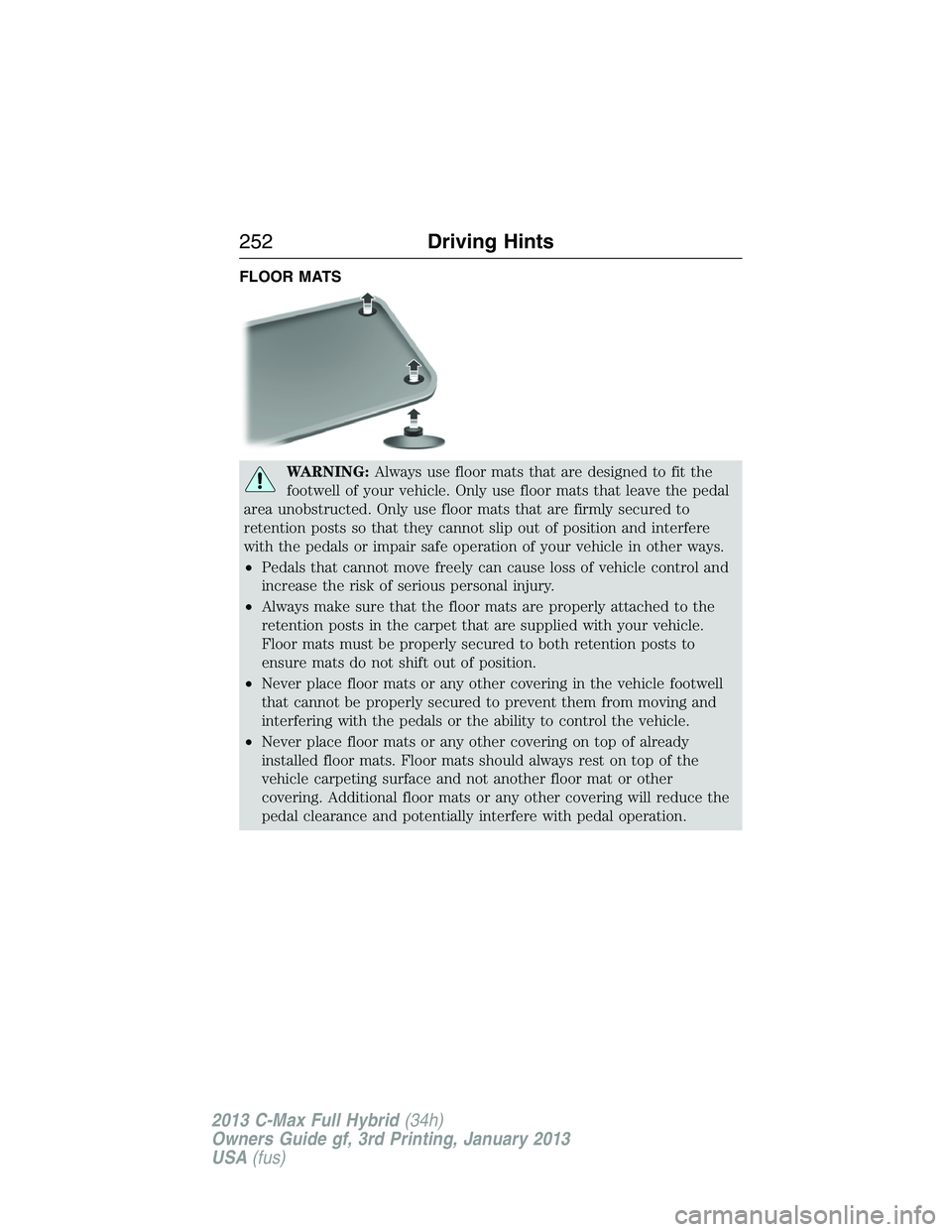
FLOOR MATS
WARNING:Always use floor mats that are designed to fit the
footwell of your vehicle. Only use floor mats that leave the pedal
area unobstructed. Only use floor mats that are firmly secured to
retention posts so that they cannot slip out of position and interfere
with the pedals or impair safe operation of your vehicle in other ways.
•Pedals that cannot move freely can cause loss of vehicle control and
increase the risk of serious personal injury.
•Always make sure that the floor mats are properly attached to the
retention posts in the carpet that are supplied with your vehicle.
Floor mats must be properly secured to both retention posts to
ensure mats do not shift out of position.
•Never place floor mats or any other covering in the vehicle footwell
that cannot be properly secured to prevent them from moving and
interfering with the pedals or the ability to control the vehicle.
•Never place floor mats or any other covering on top of already
installed floor mats. Floor mats should always rest on top of the
vehicle carpeting surface and not another floor mat or other
covering. Additional floor mats or any other covering will reduce the
pedal clearance and potentially interfere with pedal operation.
252Driving Hints
2013 C-Max Full Hybrid(34h)
Owners Guide gf, 3rd Printing, January 2013
USA(fus)
Page 254 of 552
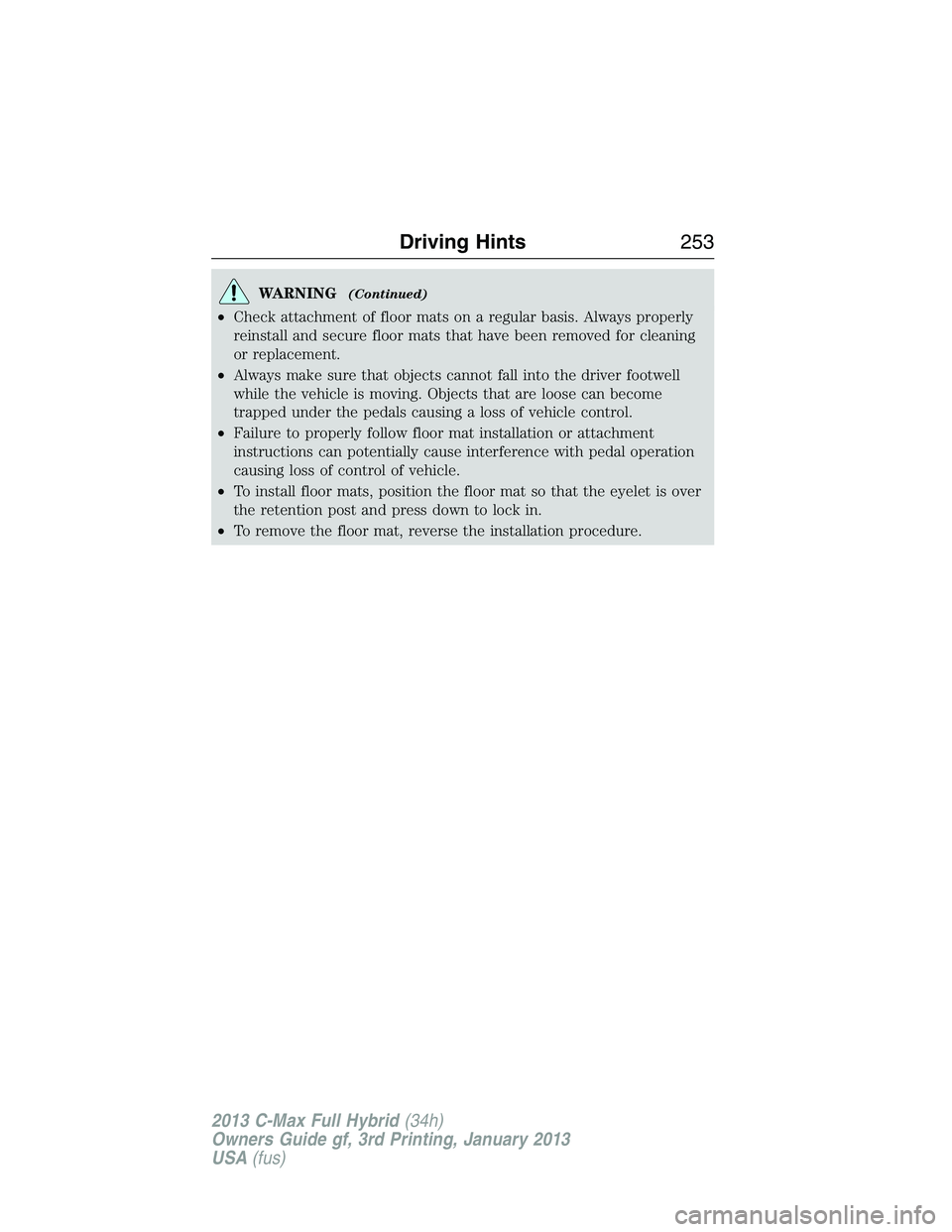
WARNING(Continued)
•Check attachment of floor mats on a regular basis. Always properly
reinstall and secure floor mats that have been removed for cleaning
or replacement.
•Always make sure that objects cannot fall into the driver footwell
while the vehicle is moving. Objects that are loose can become
trapped under the pedals causing a loss of vehicle control.
•Failure to properly follow floor mat installation or attachment
instructions can potentially cause interference with pedal operation
causing loss of control of vehicle.
•To install floor mats, position the floor mat so that the eyelet is over
the retention post and press down to lock in.
•To remove the floor mat, reverse the installation procedure.
Driving Hints253
2013 C-Max Full Hybrid(34h)
Owners Guide gf, 3rd Printing, January 2013
USA(fus)
Page 255 of 552
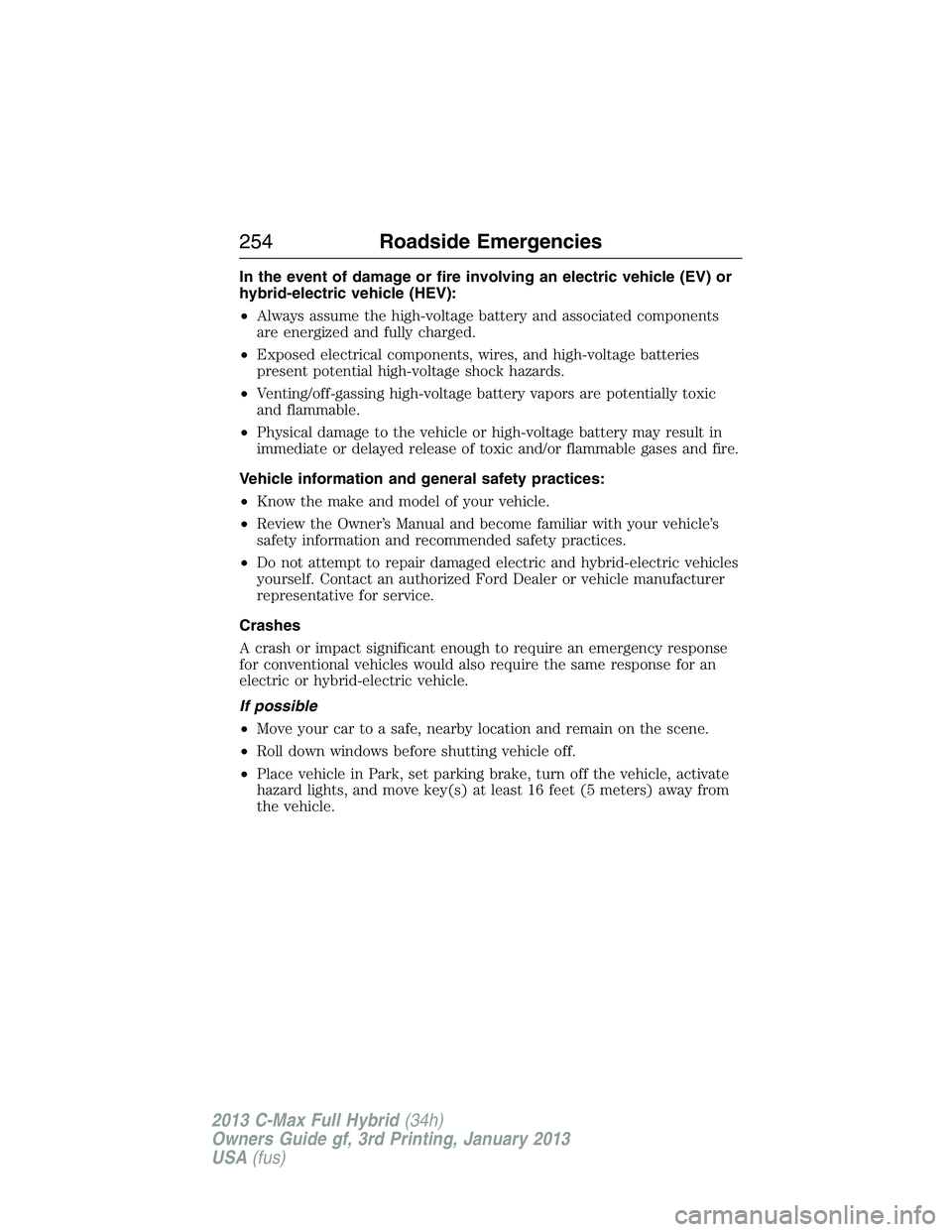
In the event of damage or fire involving an electric vehicle (EV) or
hybrid-electric vehicle (HEV):
•Always assume the high-voltage battery and associated components
are energized and fully charged.
•Exposed electrical components, wires, and high-voltage batteries
present potential high-voltage shock hazards.
•Venting/off-gassing high-voltage battery vapors are potentially toxic
and flammable.
•Physical damage to the vehicle or high-voltage battery may result in
immediate or delayed release of toxic and/or flammable gases and fire.
Vehicle information and general safety practices:
•Know the make and model of your vehicle.
•Review the Owner’s Manual and become familiar with your vehicle’s
safety information and recommended safety practices.
•Do not attempt to repair damaged electric and hybrid-electric vehicles
yourself. Contact an authorized Ford Dealer or vehicle manufacturer
representative for service.
Crashes
A crash or impact significant enough to require an emergency response
for conventional vehicles would also require the same response for an
electric or hybrid-electric vehicle.
If possible
•Move your car to a safe, nearby location and remain on the scene.
•Roll down windows before shutting vehicle off.
•Place vehicle in Park, set parking brake, turn off the vehicle, activate
hazard lights, and move key(s) at least 16 feet (5 meters) away from
the vehicle.
254Roadside Emergencies
2013 C-Max Full Hybrid(34h)
Owners Guide gf, 3rd Printing, January 2013
USA(fus)
Page 256 of 552
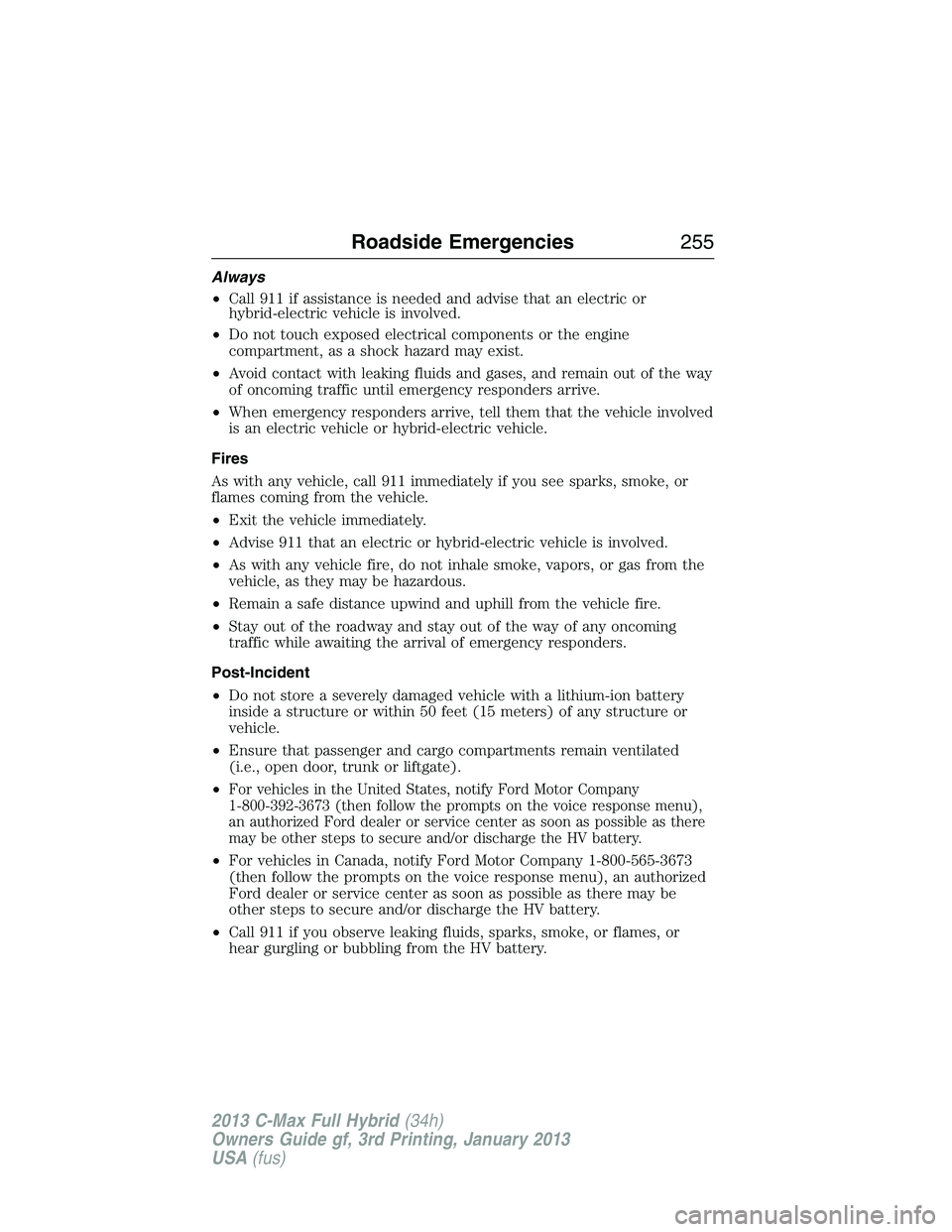
Always
•Call 911 if assistance is needed and advise that an electric or
hybrid-electric vehicle is involved.
•Do not touch exposed electrical components or the engine
compartment, as a shock hazard may exist.
•Avoid contact with leaking fluids and gases, and remain out of the way
of oncoming traffic until emergency responders arrive.
•When emergency responders arrive, tell them that the vehicle involved
is an electric vehicle or hybrid-electric vehicle.
Fires
As with any vehicle, call 911 immediately if you see sparks, smoke, or
flames coming from the vehicle.
•Exit the vehicle immediately.
•Advise 911 that an electric or hybrid-electric vehicle is involved.
•As with any vehicle fire, do not inhale smoke, vapors, or gas from the
vehicle, as they may be hazardous.
•Remain a safe distance upwind and uphill from the vehicle fire.
•Stay out of the roadway and stay out of the way of any oncoming
traffic while awaiting the arrival of emergency responders.
Post-Incident
•Do not store a severely damaged vehicle with a lithium-ion battery
inside a structure or within 50 feet (15 meters) of any structure or
vehicle.
•Ensure that passenger and cargo compartments remain ventilated
(i.e., open door, trunk or liftgate).
•
For vehicles in the United States, notify Ford Motor Company
1-800-392-3673 (then follow the prompts on the voice response menu),
an authorized Ford dealer or service center as soon as possible as there
may be other steps to secure and/or discharge the HV battery.
•For vehicles in Canada, notify Ford Motor Company 1-800-565-3673
(then follow the prompts on the voice response menu), an authorized
Ford dealer or service center as soon as possible as there may be
other steps to secure and/or discharge the HV battery.
•Call 911 if you observe leaking fluids, sparks, smoke, or flames, or
hear gurgling or bubbling from the HV battery.
Roadside Emergencies255
2013 C-Max Full Hybrid(34h)
Owners Guide gf, 3rd Printing, January 2013
USA(fus)
Page 257 of 552
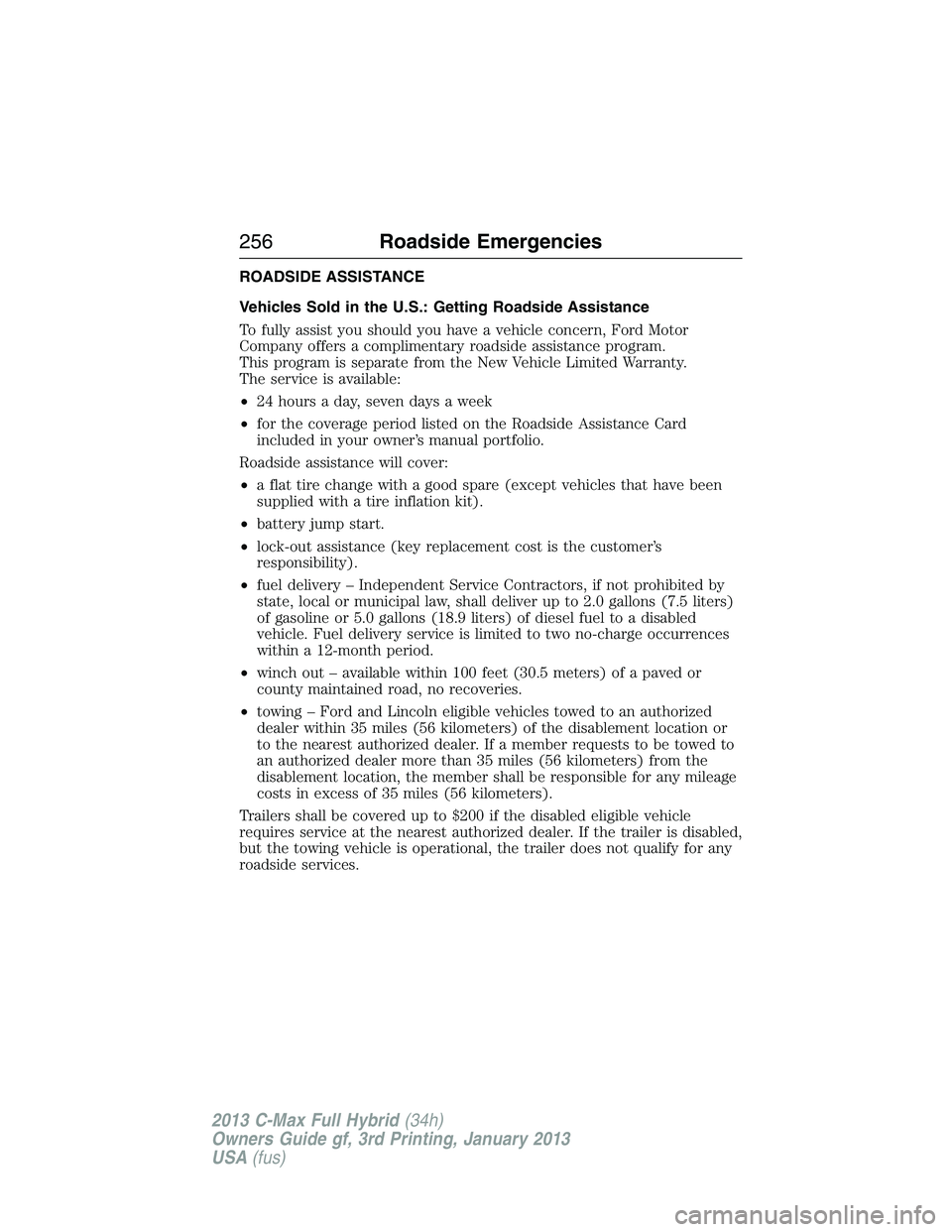
ROADSIDE ASSISTANCE
Vehicles Sold in the U.S.: Getting Roadside Assistance
To fully assist you should you have a vehicle concern, Ford Motor
Company offers a complimentary roadside assistance program.
This program is separate from the New Vehicle Limited Warranty.
The service is available:
•24 hours a day, seven days a week
•for the coverage period listed on the Roadside Assistance Card
included in your owner’s manual portfolio.
Roadside assistance will cover:
•a flat tire change with a good spare (except vehicles that have been
supplied with a tire inflation kit).
•battery jump start.
•lock-out assistance (key replacement cost is the customer’s
responsibility).
•fuel delivery – Independent Service Contractors, if not prohibited by
state, local or municipal law, shall deliver up to 2.0 gallons (7.5 liters)
of gasoline or 5.0 gallons (18.9 liters) of diesel fuel to a disabled
vehicle. Fuel delivery service is limited to two no-charge occurrences
within a 12-month period.
•winch out – available within 100 feet (30.5 meters) of a paved or
county maintained road, no recoveries.
•towing – Ford and Lincoln eligible vehicles towed to an authorized
dealer within 35 miles (56 kilometers) of the disablement location or
to the nearest authorized dealer. If a member requests to be towed to
an authorized dealer more than 35 miles (56 kilometers) from the
disablement location, the member shall be responsible for any mileage
costs in excess of 35 miles (56 kilometers).
Trailers shall be covered up to $200 if the disabled eligible vehicle
requires service at the nearest authorized dealer. If the trailer is disabled,
but the towing vehicle is operational, the trailer does not qualify for any
roadside services.
256Roadside Emergencies
2013 C-Max Full Hybrid(34h)
Owners Guide gf, 3rd Printing, January 2013
USA(fus)
Page 258 of 552
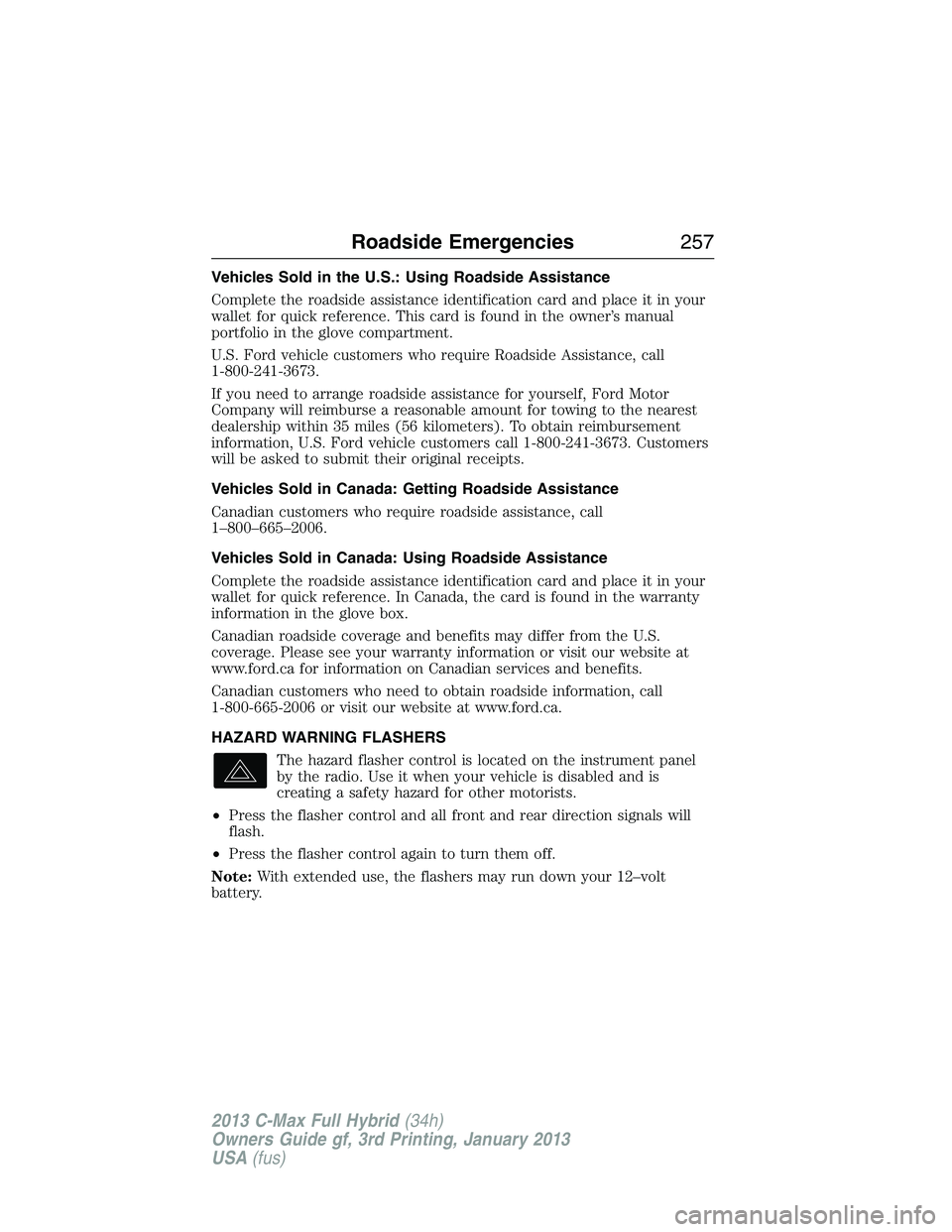
Vehicles Sold in the U.S.: Using Roadside Assistance
Complete the roadside assistance identification card and place it in your
wallet for quick reference. This card is found in the owner’s manual
portfolio in the glove compartment.
U.S. Ford vehicle customers who require Roadside Assistance, call
1-800-241-3673.
If you need to arrange roadside assistance for yourself, Ford Motor
Company will reimburse a reasonable amount for towing to the nearest
dealership within 35 miles (56 kilometers). To obtain reimbursement
information, U.S. Ford vehicle customers call 1-800-241-3673. Customers
will be asked to submit their original receipts.
Vehicles Sold in Canada: Getting Roadside Assistance
Canadian customers who require roadside assistance, call
1–800–665–2006.
Vehicles Sold in Canada: Using Roadside Assistance
Complete the roadside assistance identification card and place it in your
wallet for quick reference. In Canada, the card is found in the warranty
information in the glove box.
Canadian roadside coverage and benefits may differ from the U.S.
coverage. Please see your warranty information or visit our website at
www.ford.ca for information on Canadian services and benefits.
Canadian customers who need to obtain roadside information, call
1-800-665-2006 or visit our website at www.ford.ca.
HAZARD WARNING FLASHERS
The hazard flasher control is located on the instrument panel
by the radio. Use it when your vehicle is disabled and is
creating a safety hazard for other motorists.
•Press the flasher control and all front and rear direction signals will
flash.
•Press the flasher control again to turn them off.
Note:With extended use, the flashers may run down your 12–volt
battery.
Roadside Emergencies257
2013 C-Max Full Hybrid(34h)
Owners Guide gf, 3rd Printing, January 2013
USA(fus)
Page 259 of 552
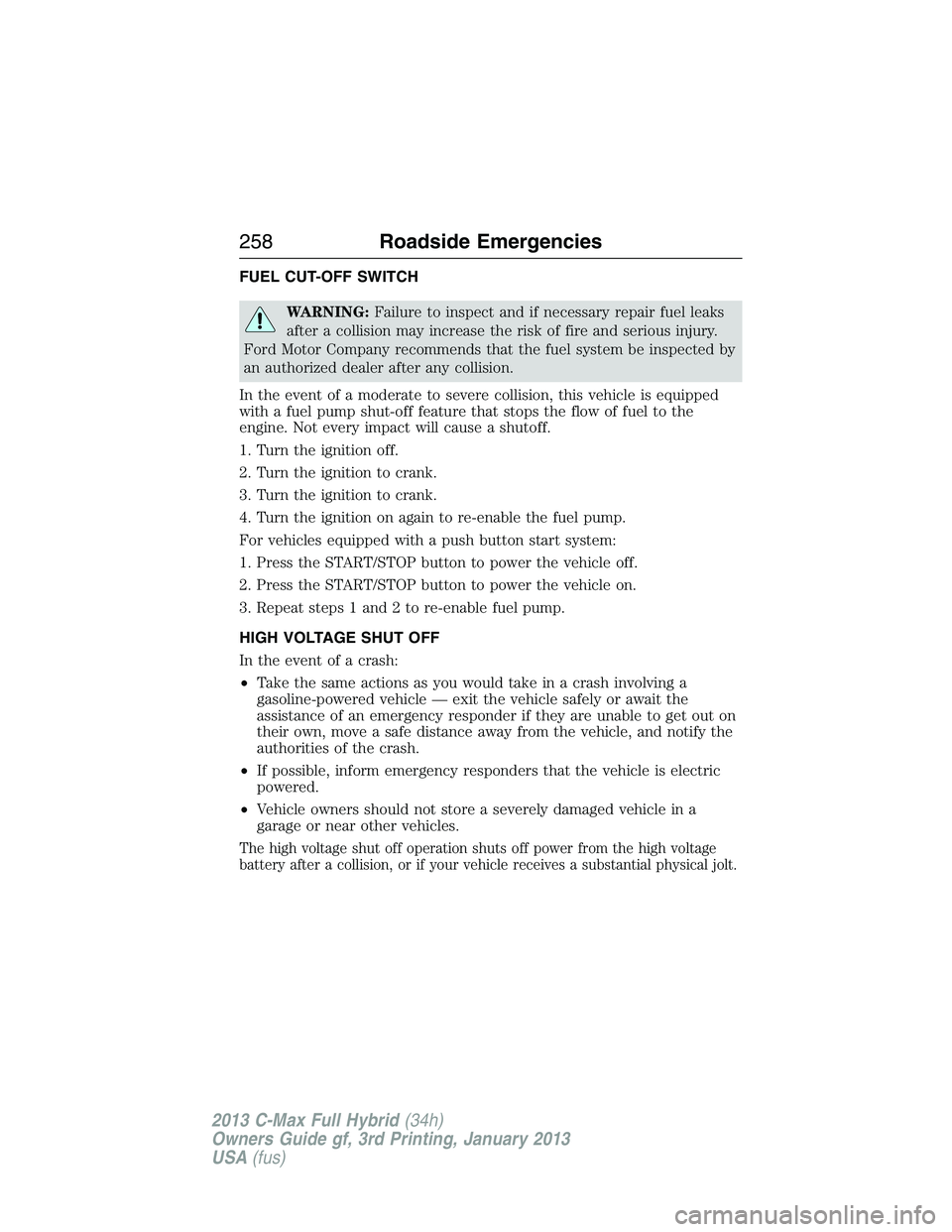
FUEL CUT-OFF SWITCH
WARNING:Failure to inspect and if necessary repair fuel leaks
after a collision may increase the risk of fire and serious injury.
Ford Motor Company recommends that the fuel system be inspected by
an authorized dealer after any collision.
In the event of a moderate to severe collision, this vehicle is equipped
with a fuel pump shut-off feature that stops the flow of fuel to the
engine. Not every impact will cause a shutoff.
1. Turn the ignition off.
2. Turn the ignition to crank.
3. Turn the ignition to crank.
4. Turn the ignition on again to re-enable the fuel pump.
For vehicles equipped with a push button start system:
1. Press the START/STOP button to power the vehicle off.
2. Press the START/STOP button to power the vehicle on.
3. Repeat steps 1 and 2 to re-enable fuel pump.
HIGH VOLTAGE SHUT OFF
In the event of a crash:
•Take the same actions as you would take in a crash involving a
gasoline-powered vehicle — exit the vehicle safely or await the
assistance of an emergency responder if they are unable to get out on
their own, move a safe distance away from the vehicle, and notify the
authorities of the crash.
•If possible, inform emergency responders that the vehicle is electric
powered.
•Vehicle owners should not store a severely damaged vehicle in a
garage or near other vehicles.
The high voltage shut off operation shuts off power from the high voltage
battery after a collision, or if your vehicle receives a substantial physical jolt.
258Roadside Emergencies
2013 C-Max Full Hybrid(34h)
Owners Guide gf, 3rd Printing, January 2013
USA(fus)
Page 260 of 552
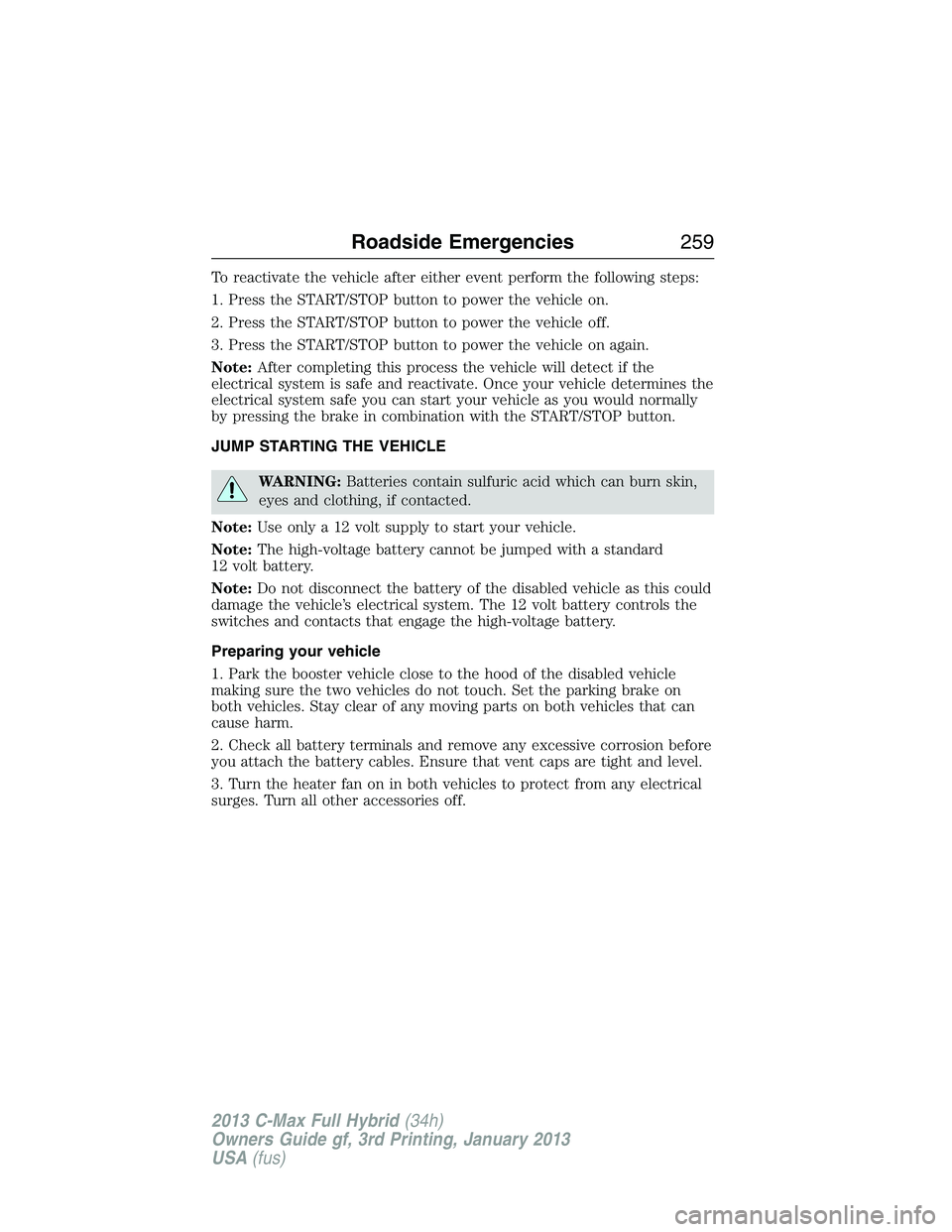
To reactivate the vehicle after either event perform the following steps:
1. Press the START/STOP button to power the vehicle on.
2. Press the START/STOP button to power the vehicle off.
3. Press the START/STOP button to power the vehicle on again.
Note:After completing this process the vehicle will detect if the
electrical system is safe and reactivate. Once your vehicle determines the
electrical system safe you can start your vehicle as you would normally
by pressing the brake in combination with the START/STOP button.
JUMP STARTING THE VEHICLE
WARNING:Batteries contain sulfuric acid which can burn skin,
eyes and clothing, if contacted.
Note:Use only a 12 volt supply to start your vehicle.
Note:The high-voltage battery cannot be jumped with a standard
12 volt battery.
Note:Do not disconnect the battery of the disabled vehicle as this could
damage the vehicle’s electrical system. The 12 volt battery controls the
switches and contacts that engage the high-voltage battery.
Preparing your vehicle
1. Park the booster vehicle close to the hood of the disabled vehicle
making sure the two vehicles do not touch. Set the parking brake on
both vehicles. Stay clear of any moving parts on both vehicles that can
cause harm.
2. Check all battery terminals and remove any excessive corrosion before
you attach the battery cables. Ensure that vent caps are tight and level.
3. Turn the heater fan on in both vehicles to protect from any electrical
surges. Turn all other accessories off.
Roadside Emergencies259
2013 C-Max Full Hybrid(34h)
Owners Guide gf, 3rd Printing, January 2013
USA(fus)